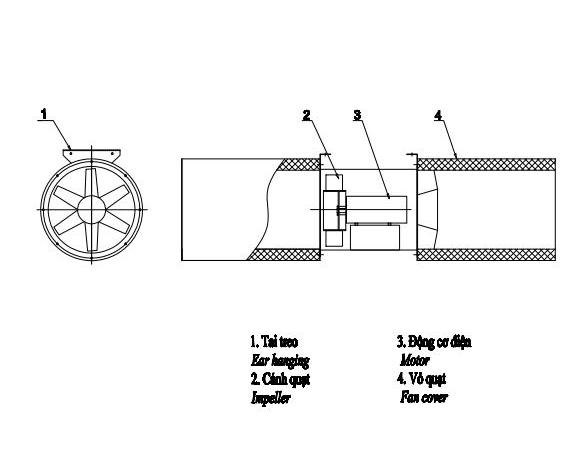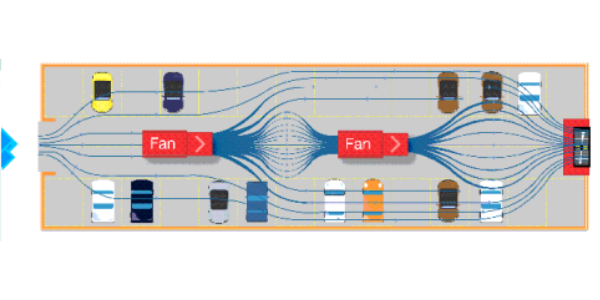The basement is usually a place designed underground, in order to save space and create aesthetics for the space. But the basement is a place that contains very little air, causing a feeling of oppression, discomfort, containing many harmful gases such as NO, CO2, SO2… extremely important. The following article, P69 Company will guile you to install Jetfan ventilation fans in details, please refer to!
What is Jetfan fan?
Jetfan is a type of fan designed to serve different needs of users such as basement ventilation, fresh air supply, toxic smoke extraction… used a lot in today’s constructions.
Not only helps save space. Reduce operating costs and noise. Making the basement a lighter environment, this type of Jetfan also overcomes the disadvantage of using expensive and cumbersome ductwork that not all industrial fans can do.

The fan can be designed with a 2-head sound absorption system, so it will have a low noise level suitable for the condition that noise cannot be excaped in the basement area.
Structure of jetfan fan
Basically, the structure of a jetfan fan includes the following main parts:
- The fan shell is made of durable powder-coated steel to increase aesthetics, protect the fan from the impact of the environment, and increase the life of the fan.
- Install genuine motors such as Teco, ABB, Siemens, durable operation, fully meet fire prevention and rescue standards and IP55 protection level, allowing easy cleaning with faucets high pressure spray
- Dynamically balanced propellers on an ISO-certified digital balancer
- Products are genuine 12-month warranty

How to choose the right jetfan fan for the usage environment
Currently on the market there are two popular types of Jetfan fans: Axial jetfan and flat centrifugal jetfan. Depending on the purpose of use or the installation project, you can choose the most suitable product. Basically, these two types of fans will have the following characteristics:
Axial Jetfan fan
An axial fan, usually installed in the case of basements with high ceiling space.
Flat centrifugal Jetfan fan
Is a series of “centrifugal fans” operating on the principle of centrifugal force when rotating the propeller to create differential pressure to create suction and thrust, usually installed mainly in the case of low basements and small spaces.
Why use Jetfan ventilation fans for basements and parking lots?
Basements and parking lots are often built underground to save space and use features. However, this design will make it difficult for air to circulate. and less sunlight causes many harmful substances.
Due to the large volume of traffic such as motorbikes, cars, etc., many toxic gases are released in the parking lot and basement. The risk of fire and explosion increases. Therefore, the use of ventilation fans is extremely important, and almost mandatory in the design of buildings.
Jetfan ventilation fans are an optimal solution, with the operating principle allowing to operate much more efficiently than installing natural ventilation systems. At the same time, it helps to save operating and construction costs. Space saving and installation space. Large wind volume but low noise level does not cause noise pollution.
Instructions for installing a detailed standard Jetfan ventilation fan
In this section, I will give some notes on the installation guide of Jetfan ventilation fans so that you can have a better view of the design of car basement ventilation in both domestic and foreign projects.
Step 1: Categorize the system
There are two basic types of car basement ventilation, which are:
1. Ventilation design type 1, the system includes:

– Supply fan, exhaust fan
– Air supply and suction pipes
From the above basic differences, we see that the difference between the two types of systems is the equipment and pipeline components.
2. Type 2 ventilation design, the system includes:

– Exhaust fan (level fan)
– The jetfan fans push the wind
From the above basic differences, we see that the difference between the two types of systems is the equipment and pipeline components.
Step 2: Analyze how to design 2 types of ventilation
Analysis of the design of 2 types of ventilation include:
1. Ventilation design 1
Determine the level of basement ventilation with requirements such as emergency ventilation, division of ventilation zones…
Calculation of basement ventilation flow for suction and supply systems.
Calculation of pipelines for suction and supply systems, head for 1 speed / 2 speed fans.

Calculation of pipe elevation, position of supply or suction fan shafts to the outside of the building.
Calculation of wind mouth size, wind louver.
Selection of exhaust fan, level, CO sensor…
Show ventilation principle diagram, control, operation status table…
2. Second type ventilation design
Determine the level of basement ventilation with requirements such as emergency ventilation, division of ventilation zones…
Calculation of basement ventilation flow for suction and supply systems.
Calculate the selection of jetfan fans pushing the wind 1 speed / 2 speed and reasonable arrangement of distance, pitch, angle of inclination of the fan…
For tunnels from 2,600 m2 or more, it is necessary to check with CFD software that simulates wind flow.
Calculation of wind mouth size, wind louver.
Selection of exhaust fan, level, CO sensor…
Show ventilation principle diagram, control, operation status table…

Step 3: Conclusion
Of the two designs above, type 2 is the design with more advantages because it significantly reduces the air ducts, the air outlet in the tunnel in both supply and intake systems.
For large-area tunnels, the ventilation volume is also large. This leads to a type 1 design that will encounter some obstacles such as:
Coordination between ductwork and other MEP systems is difficult. Affects the traffic height of the tunnel. Causes loss of beauty due to many pipes. Large fans with long ducts will make more noise, so they have to deal with a lot of noise.
Type 2 design is often widely applied in foreign projects with large car tunnels. However, form 1 is still designed for medium and small tunnels or tunnels of high height.
In addition, for parking lots on the ground or parking floors with open surrounding surfaces, a design like type 2 is most suitable, but note that you only need to use jetfan fans without supply and exhaust fans. .
In our country today, most of the projects are designed in the first form and approved by the authorities of the state.
For type 2, the limited validation of CFD simulation makes it less widely used.
Contact information P69 – M&E Contractor
Address: No. 6/165C Xuan Thuy, Cau Giay District, Hanoi
Website: https://p69.com.vn/
Hotline : 02422121212 – 0965937799
Email: kd@cokhip69.com.vn
Facebook: https://www.facebook.com/p69nhathaucodien
LinkedIn: https://www.linkedin.com/in/congtyp69/
Youtube : https://www.youtube.com/channel/UCOUwCnE5iGj8iqe_ZIUM7oA

